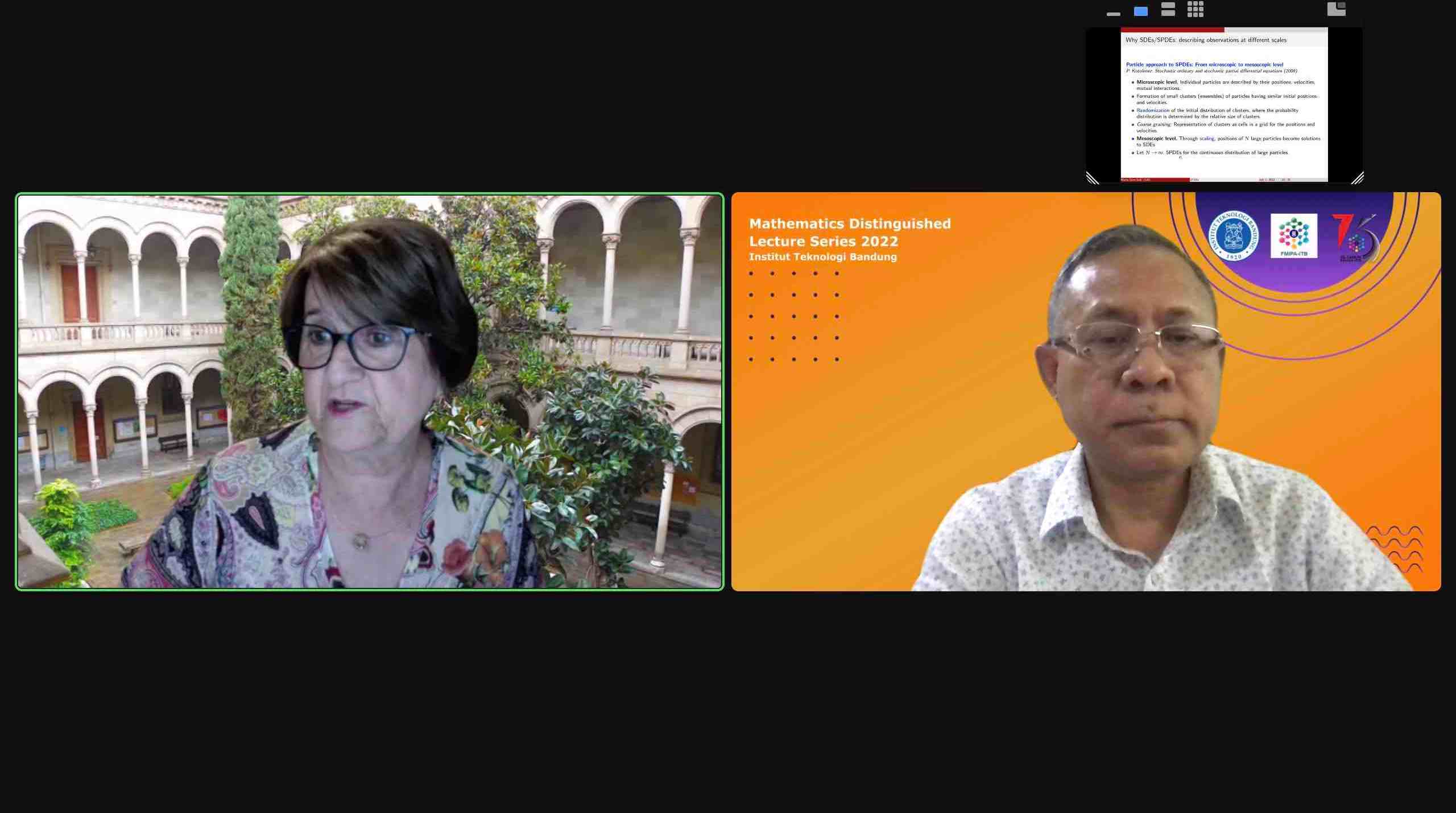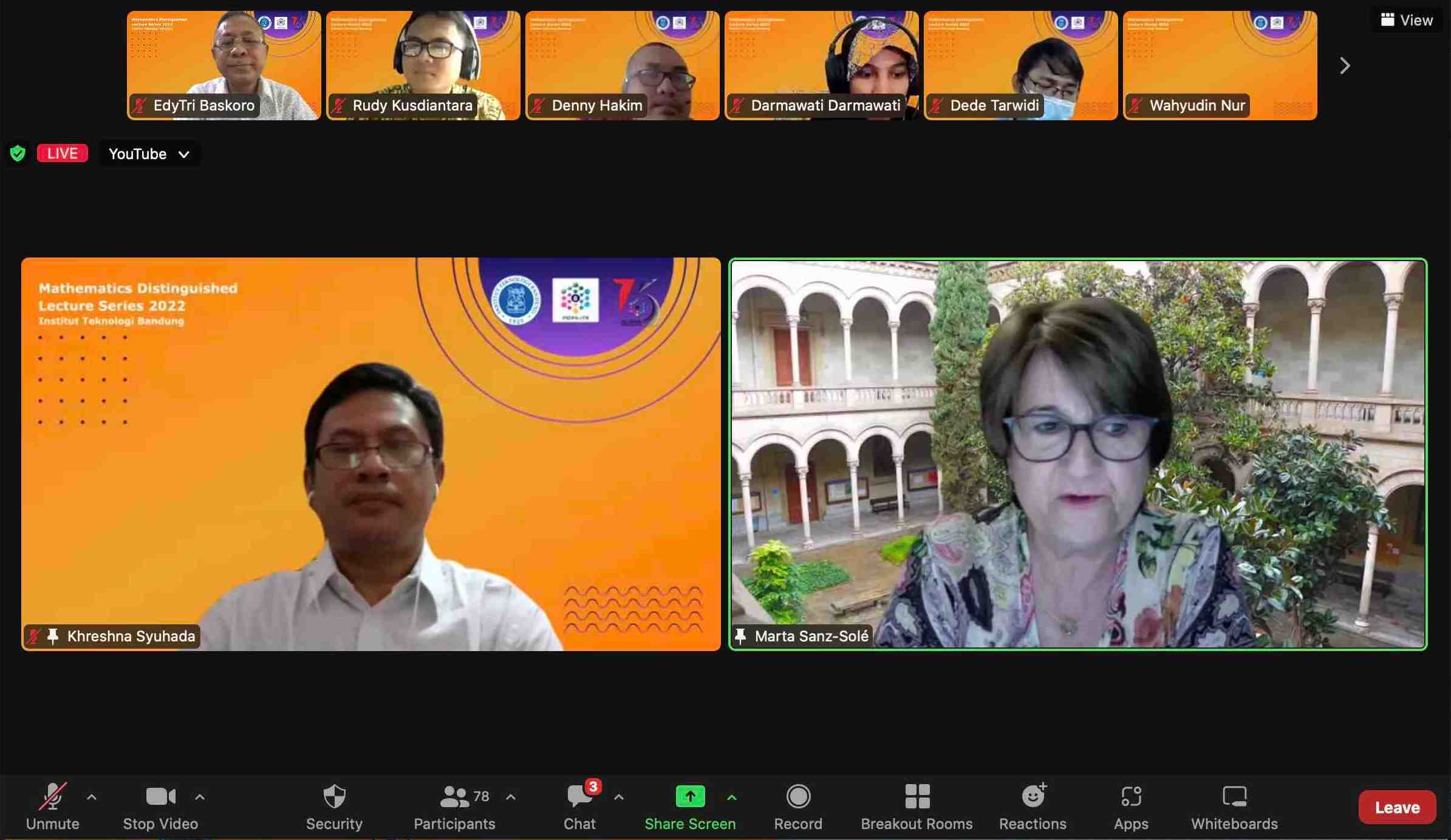Mathematics Distinguished Lecture Series 2022: The Use of SPDE Equation in Sound Modeling

BANDUNG, itb.ac.id – Mathematics is a very important field of science that can be implemented in all aspects of our life. Systems or tasks can be made easier by using mathematics. To promote mathematical research culture to the ITB academician, the Faculty of Mathematics and Natural Sciences ITB held another "Mathematics Distinguished Lecture Series 2022" webinar on Friday (1/7/2022).
In this general lecture, Prof. Marta Sanz-Sole was invited to give a presentation on the "Modeling with Noise" topic. Professor Marta Sanz-Sole is a mathematics professor from Barcelona University (Spain) and one of the most distinguished mathematics figures in the world for her research in the stochastic field, especially on the Stochastic and Partial Differential Equation (SPDE). Along with active teaching, she also carries out various research and has published multiple mathematics journals.
Prof. Edy Tri Baskoro, the Head of MDLS 2022, said that Professor Marta Sanz-Sole is one of the mathematicians that has given a precious contribution to the field of mathematics. She has around 50 publications that are indexed by Scopus, a top scientific journal.

"In 2017, she was awarded the Real Sociedad Matemática Española Medal for her scientific contributions and position, in addition to being provided with a relevant international service by the Royal Spanish Mathematical Society (RSME). RSME is a Spanish scientific community that is dedicated to mathematics, which its objective, as what was written in its chapters, is to promote and spread mathematics and its applications in addition to promoting its research and education in every level of education," he added.
The lecture began with the history and the definition of the stochastic partial differential equation (SPDE) and its application in modeling. Then it was continued with a close explanation of SPDE expression, stochastic integral, and its random field solutions. Special problems on SPDE were also discussed.
In this webinar topic, she described PDE (Partial Differential Equation) as an equation that involves two unknown functions and is composed of two or more variables. In addition to having its root on the normal differential equation, this equation also has a definite partial derivative. "If you try to simulate a solution for this equation, the graphic profile will show a phenomenon in which the initial profile results will diffuse".
SPDE is one of the types of PDE that requires several new elements to the PDE equation: sample room and undefined external power/force. This equation is also characterized by its random initial conditions and limits to add the factor of chaos into it. Its numeric simulation also shows a 'diffusion' behavior.
"The invention of SPDE can be traced back to 1944-1946 when Kyoshi Ito published two journals on the differential equation and stochastic integration theory," Prof Martha added.
She said, "Ito discovered that the diffusion probability law is actually a probability law from some stochastic processes that are also the solutions of some equations," she explained. A simple version of SPDE can be found in Louis Bachelier (1900) and Paul Langevin (1908) works.
SPDE is very useful for different scale observations, from the microscopic level to the mesoscopic level. On the particulate approach, SPDE can be implemented into its case study modeling. An example of this is a tone that is played by a guitar during a sandstorm. According to Walsh (1986), guitar string is being bombarded by sand particles independently in different positions and times. Random fluctuating external forces are also present in this phenomenon, which are the guitar sounds themselves. With the wave equations and other factors that have been mentioned, SPDE-based modeling for this case can be designed. This modeling can also be applicated to mimic the potential electricity in the neuron as a neural response inside the human body.

With the SPDE simulation, data, properties, approximations, and behaviors, the solution as a whole can be determined. SPDE framework itself consists of every criterion, in which its solution covers path and density on the fixed points.
This MDLS has been held routinely by the Faculty of Mathematics and Natural Sciences ITB Mathematics Study Program since 2021. In 2021, MDLS was held four times and has invited various internationally distinguished mathematics scholars. The four scholars that were invited are Prof. Motoko Kotani (Japan), Prof. Christophe Ritzenhaler (France), Prof. Hans Munthe-Kaas (Norwegia), and Prof. Richard A. Brualdi (United States). This year MDL has been held three times, three scholars that have been invited are Prof. Martin Hairer (England), Prof. Edy Soewono (Indonesia), and in this third chapter, Prof. Marta Sanz-Sole.
This third chapter was attended by around 95 participants (lecturer, researcher, and bachelor, master, and doctoral students) from universities in Indonesia, the Philippines, Thailand, Spain, and several other countries. The MDLS 2022 record can be watched at https://www.youtube.com/c/MathematicsITB/videos. Further information on the next MDL chapters can be accessed at https://math.itb.ac.id/mdls/.
Reporter: Ruth Nathania (Environmental Engineering, 2019) and I Palton Anuwiksa (Faculty of Mathematics and Natural Sciences ITB Doctoral Student)
Translator: Favian Aldilla R (Civil Engineering, 2019)

scan for download



